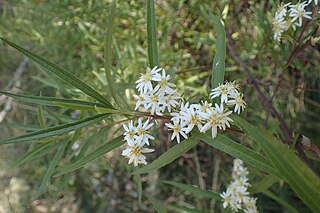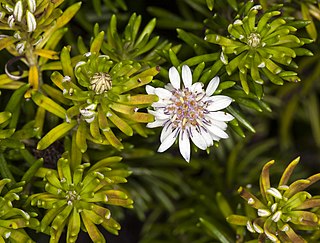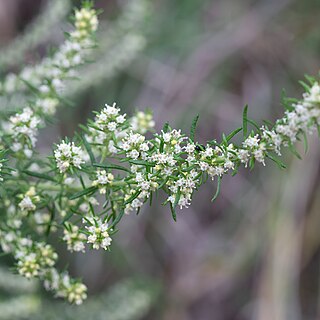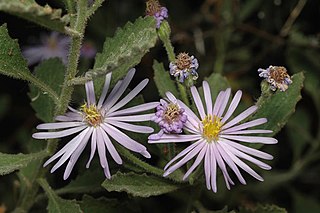
Olearia teretifolia, commonly known as cypress daisy-bush, is a species of flowering plant in the family Asteraceae and is endemic to south-eastern continental Australia. It is a slender, erect to spreading shrub with more or less sessile, linear leaves pressed against the stem, and white and yellow, daisy-like inflorescences.

Olearia axillaris, commonly known as coastal daisy-bush, coast daisy-bush or coastal daisybush is a species of flowering plant in the family Asteraceae and is endemic to coastal areas of Australia. It is an erect, bushy shrub with densely cottony-hairy branchlets, aromatic, linear to narrowly elliptic or narrowly lance-shaped to egg-shaped leaves with the narrower end towards the base and small white and yellow, daisy-like inflorescences.

Olearia stuartii is a species of flowering plant in the family Asteraceae and is endemic arid parts of inland Australia. It is compact, spreading shrub or undershrub with lance-shaped leaves and blue to mauve and yellow, daisy-like inflorescences.

Olearia megalophylla, commonly known as large-leaf daisy bush, is a species of flowering plant in the family Asteraceae and is endemic to south-eastern continental Australia. It is a spreading shrub with egg-shaped to elliptic leaves and white and yellow, daisy-like inflorescences.

Olearia viscidula, commonly known as the viscid daisy bush or wallaby weed, is a species of flowering plant in the family Asteraceae and is endemic to eastern New South Wales. It is a shrub with scattered narrow elliptic or egg-shaped leaves that are paler on the lower surface, and panicles of white flowers arranged in leaf axils.

Olearia homolepis is a species of flowering plant in the family Asteraceae and is endemic to Western Australia. It is a shrub with linear leaves and white or blue and yellow, daisy-like inflorescences.

Olearia ballii, commonly known as mountain daisy, is a species of flowering plant in the family Asteraceae and is endemic to Lord Howe Island. It is a dense shrub with crowded linear leaves and small, purplish and white, daisy-like inflorescences.

Olearia mooneyi, commonly known as pumpkin bush, is a species of flowering plant in the family Asteraceae and is endemic to Lord Howe Island. It is a shrub or small tree with hairy, elliptic to egg-shaped leaves with the narrower end towards the base, and white and pale yellow, daisy-like inflorescences.

Olearia iodochroa, commonly known as the violet daisy bush, is a species of flowering plant in the family Asteraceae and is endemic to south-eastern continental Australia. It is a shrub with branchlets densely covered with whitish hairs, narrowly egg-shaped leaves with the narrower end towards the base, and white or mauve, and cream-coloured, yellow or blue, daisy-like inflorescences.

Olearia pannosa, commonly known as silver-leaved daisy or velvet daisy-bush, is a species of flowering plant in the family Asteraceae and is endemic to south-eastern continental Australia. It is a spreading undershrub or shrub with egg-shaped or heart-shaped leaves, and white and yellow daisy flowers.
Olearia adenolasia, commonly known as woolly-glandular daisy-bush, is a species of flowering plant in the family Asteraceae. It is a small upright shrub with sticky leaves and blue-purple or white daisy flowers.

Olearia exiguifolia commonly known as small-leaved daisy bush, is a species of flowering plant in the family Asteraceae and is endemic to south-western Australia. It is an erect or straggly shrub with broadly egg-shaped leaves with the narrower end towards the base, and white and yellow, daisy-like inflorescences.
Olearia chrysophylla is a species of flowering plant in the family Asteraceae and is endemic to eastern Australia. It is a shrub with scattered elliptic leaves, and white and yellow, daisy-like inflorescences.

Olearia cydoniifolia is a species of flowering plant in the family Asteraceae and is endemic to eastern Australia. It is a shrub with scattered elliptic leaves, and white and yellow, daisy-like inflorescences.

Olearia ferresii is a species of flowering plant in the family Asteraceae and is endemic to central Australia. It is an erect, aromatic shrub with elliptic to lance-shaped leaves and white and yellow, daisy-like inflorescences.

Olearia gravis is a species of flowering plant in the family Asteraceae and is endemic to south-eastern Australia. It is a shrub with elliptic or egg-shaped leaves and white and yellow, daisy-like inflorescences.

Olearia nernstii is a species of flowering plant in the family Asteraceae and is endemic to eastern Australia. It is a shrub with scattered egg-shaped to elliptic leaves with toothed or prickly edges, and white and yellow, daisy-like inflorescences.
Olearia picridifolia, commonly known as rasp scrub-daisy, is a species of flowering plant in the family Asteraceae and is endemic to southern continental Australia. It is a low, spreading shrub with narrowly egg-shaped or narrowly elliptic leaves, and blue, mauve or white and yellow, daisy-like inflorescences.

Olearia tubuliflora, commonly known as rayless daisy-bush, is a species of flowering plant in the family Asteraceae and is endemic to south-eastern continental Australia. It is a slender, erect shrub with linear or narrowly elliptic leaves and yellow, daisy-like inflorescences but with the ray florets lacking a ligule.

Olearia xerophila is a species of flowering plant in the family Asteraceae and is endemic northern Australia. It is an erect subshrub with elliptic to broadly elliptic leaves and violet, blue or mauve and yellow, daisy-like inflorescences.


















